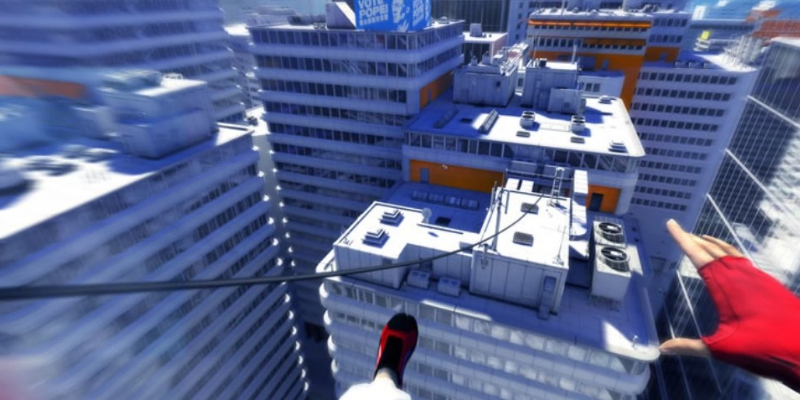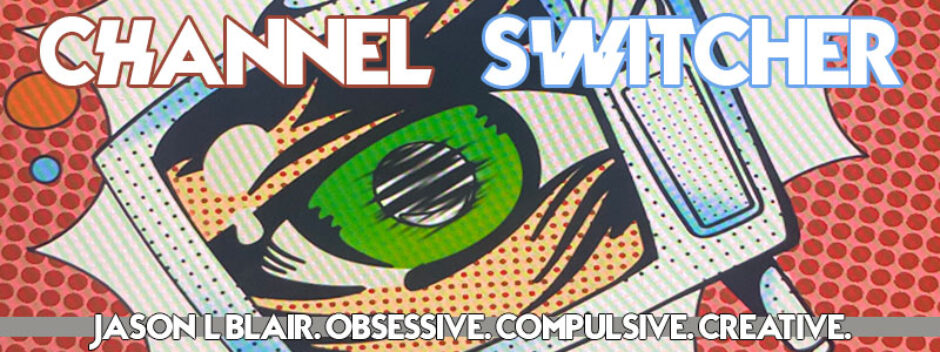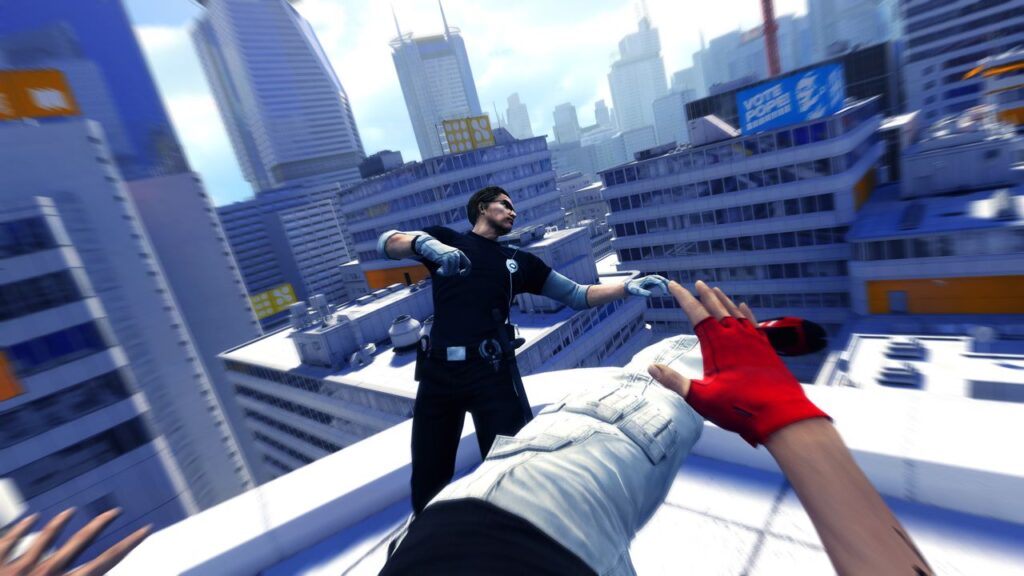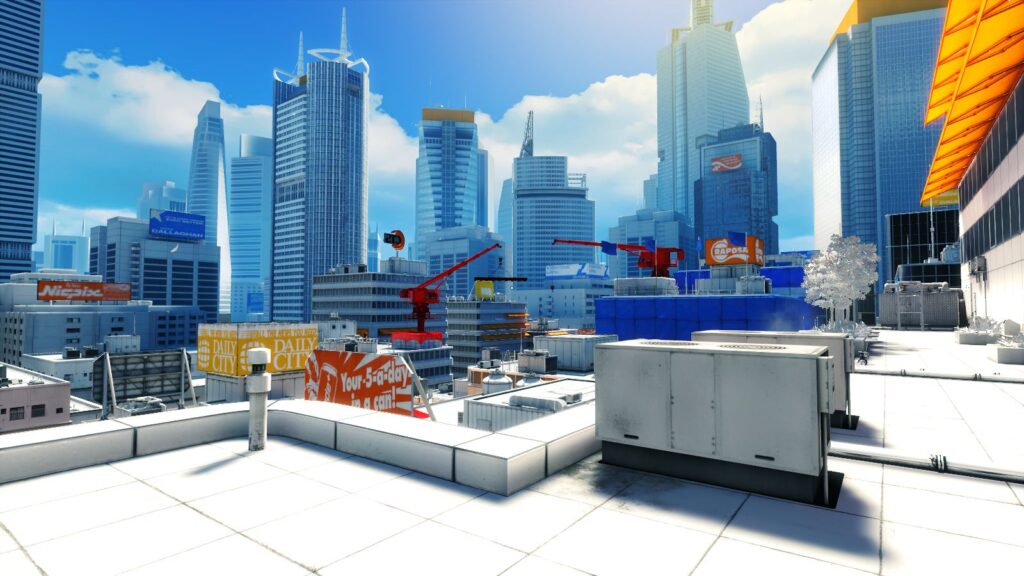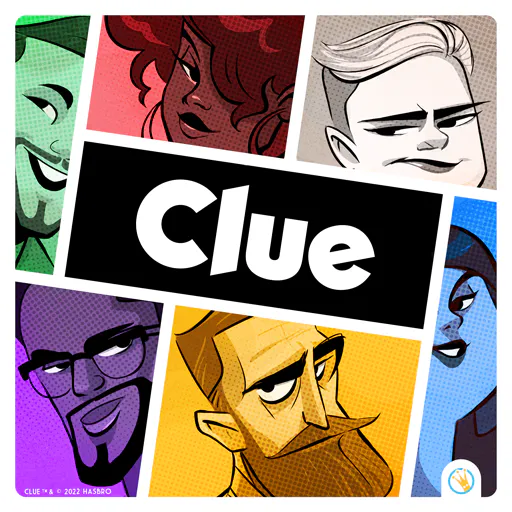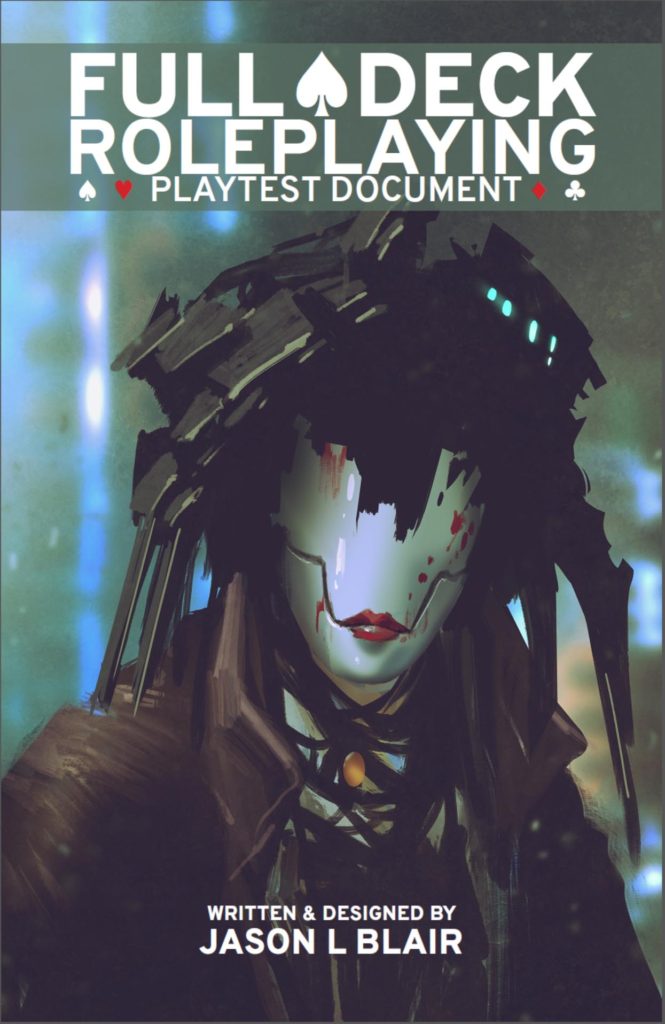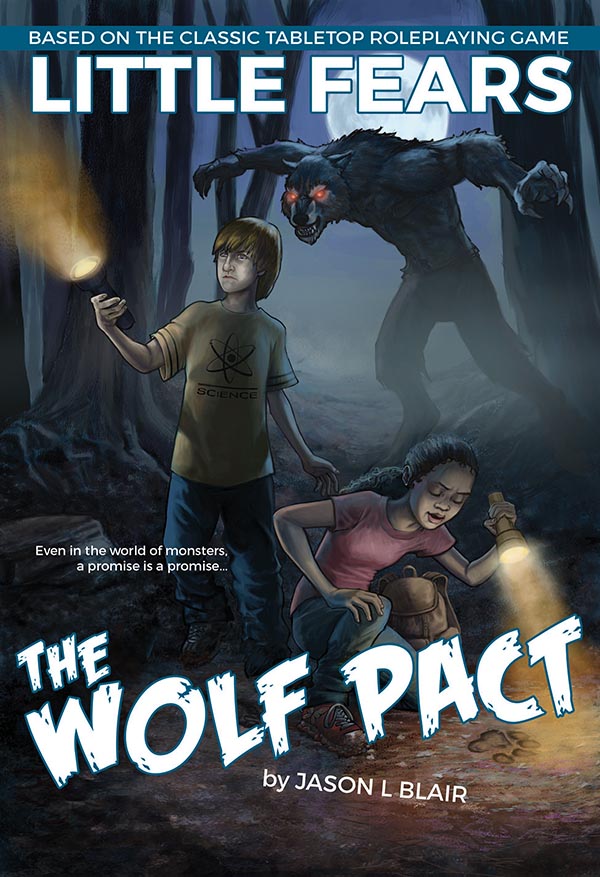While my dream projects tend to bounce around thematically, the “dark future” genre is a favored one and I’d love to do something in it. The katana-laded trenches and mirror shades, the rain-slicked streets and neon skies, the virtual surreality and hope amidst suffocating authority, the world of the dark future oozed urgency and style. It also, if you believed the source material, was dark. Not just thematically dark, not just conceptually dark, but actually, visibly dark. From Blade Runner to Altered Carbon, the dystopian world of tomorrow takes place primarily at night. If you know me at all—and, if you’re one the five people reading this, you probably do—you know I love a good shake-up. Which is exactly what Mirror’s Edge is: a fresh, bright take on an old, dark idea.
Developed by DICE and published by EA, Mirror’s Edge was part of the same publisher push that gave us Army of Two and Dead Space. It was a concerted effort by EA to inject some new blood into its system. As someone who loves bold, new ideas, I was super excited for all of them for different reasons. While Army of Two promised badass third-person coop and Dead Space was all-in on tense, atmospheric third-person horror, Mirror’s Edge was first-person action-parkour. The game takes place in a near future of seemingly perfect bliss—a state of ignorance made possible by the oppressive machinations of a government dedicated to maintaining absolute control. The main character, Faith, is a Runner, a courier who subverts the system by delivering goods and data under the radar. Her ability to move through the city quickly is key to the story—she needs items and information to get from A to B fast without being detected—and it’s also key to the gameplay. Mirror’s Edge is all about movement. You navigate the environment using Runner’s Vision which is the developer’s reasoning for the stark look of the game world. The city is achingly sterile with most rooftops, walls, and other environmental elements presented as stark white. Color is used to deliver information to the player quickly and cleanly. After all, the goal is to achieve fluidity. If a player is in that zen-like flow state, you don’t want to unnecessarily draw them out of it. Using bright spots of green, blue, yellow, and red let you guide the player without breaking their stride. Mirror’s Edge had a lot of goals and, when it worked, man, it worked. You were running across rooftops, sliding down ramps, bouncing between billboards, and busting open doors like an Olympiad. It did occasionally draw you out for some forced combat or comic style cutscenes—both of which had their detractors.
If you weren’t paying attention (or weren’t around) back in 2008 when the game hits shelves, you might not appreciate how far of a departure Mirror’s Edge was from everything else on the market. The game had a look singularly its own. This was the height of the PS3/360 era when AAA games were all competing to be the most brown. Drab earthtones ruled the day and, while I love that generation dearly, the titans of the AAA space felt a little too self-serious and sad. Yes, the Wii was still the hot thing and you could depend on Nintendo to bring the bright and colorful but Mirror’s Edge did so in a game that was first-person, action-focused, and targeted toward core gamers. You could tell a screenshot was from Mirror’s Edge at a glance from a far distance. Even now, over sixteen years later, a single screenshot pulls at something inside me.
Mirror’s Edge was followed by a mobile game and a Flash game (!!!) in 2010 but, unlike fellow classmates Army of Two and Dead Space, while originally planned as a trilogy, it didn’t launch a series. Rumors of a sequel abounded for a bit but nothing was announced until the reveal of 2016’s Mirror’s Edge: Catalyst. A soft reboot of the series, the game retooled some key concepts while retaining a lot of the core gameplay. It moved from tighter, more linear spaces to an open world complete with side missions. It introduced skill trees that allowed players to expand Faith’s moveset. The final big change is that it got rid of gunplay—at least for the player—which made Faith’s only choices in combat either evading or subduing enemies. Catalyst was accompanied by a tie-in comic subtitled Exordium. Sadly, that’s all there is for the series.
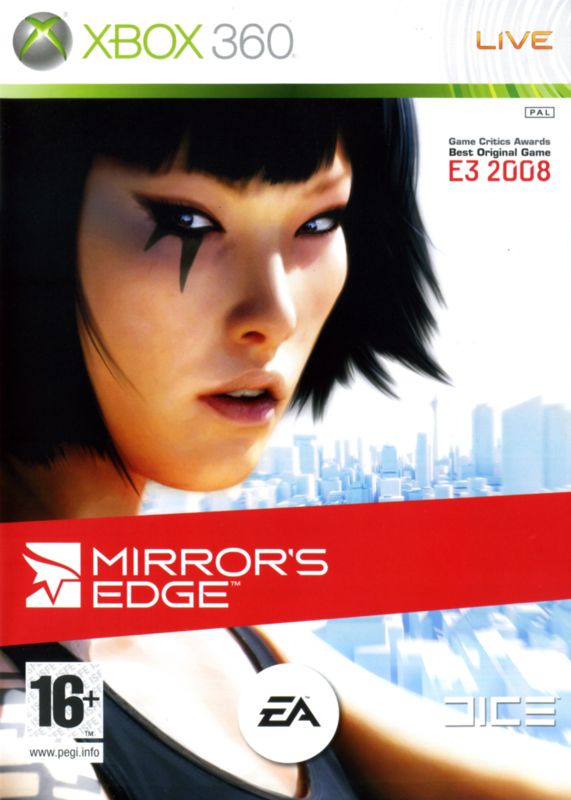
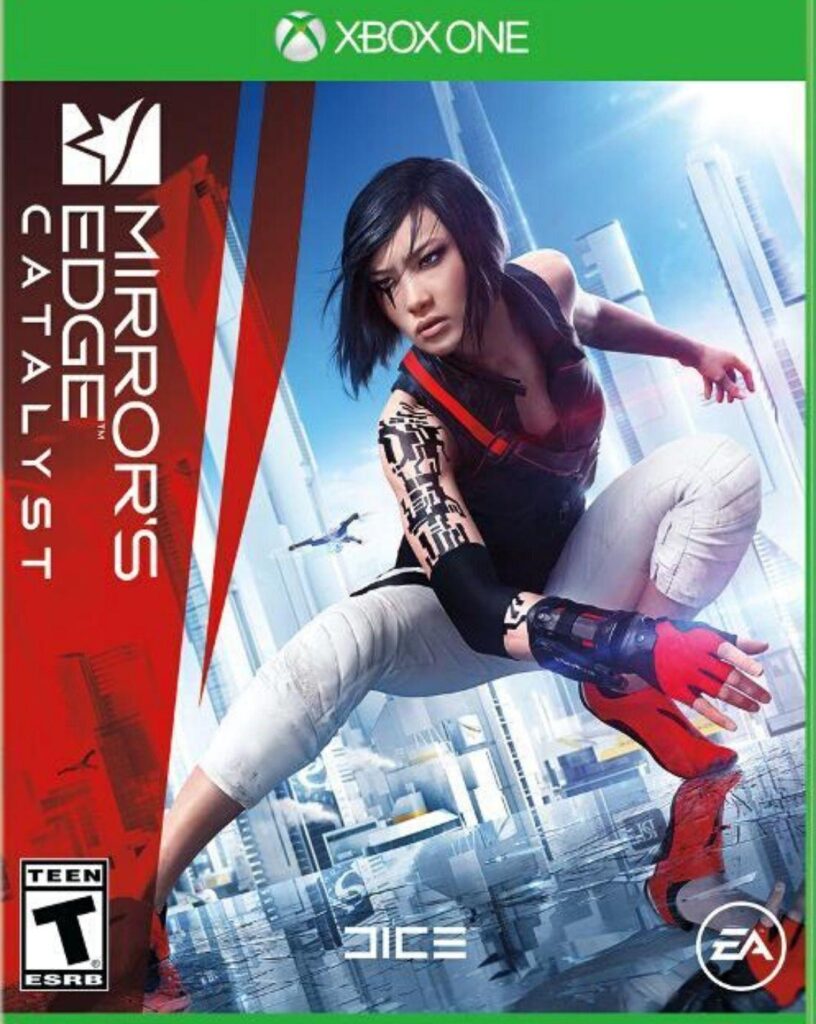
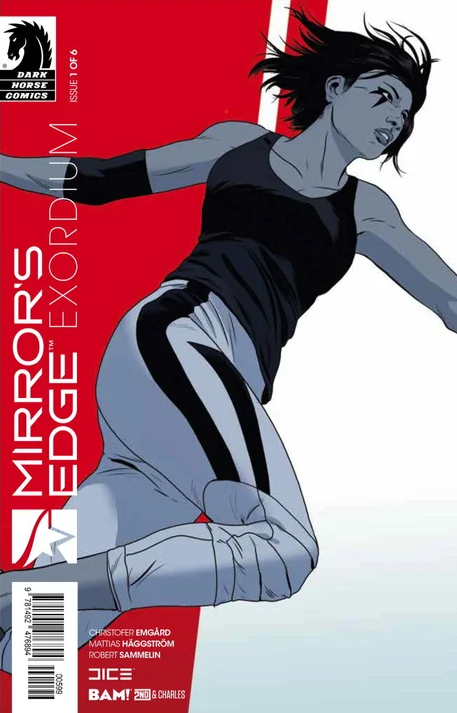
I’ve been a cyberpunk fan for over thirty years. R. Talsorian’s classic tabletop game, Cyberpunk 2020, is what turned me onto the genre and I was immediately hooked. This led me to William’s Gibson’s seminal work, Neuromancer (and Mona Lisa Overdrive, Virtual Light, and my favorite of his, Idoru). From there, I read books like Richard K. Morgan’s Altered Carbon, watched movies like Blade Runner (of course), got into the brilliant-but-canceled Max Headroom television series, and listened to any music that just felt “cyberpunky” to me. I’ve even made a few stabs at creating my own dark future worlds but never pushed anything across the finish line. To this day, I’ll dive into pretty much anything set in a dimly-lit version of the near future.
But I love Mirror’s Edge because it stands in stark contrast to cyberpunk’s aesthetic. It’s a world of hope where players aren’t sticking to the shadows but running through daylight. Where some dystopian worlds see their protagonists using the broken rules to their own ends or resisting oppression through violence, Mirror’s Edge takes a third approach: fighting the machine without being seen. Our hero moves out in the open yet under the radar, using the hubris and folly of the oppressors against themselves.
Because of both how it looked and how it played, Mirror’s Edge was unique upon its release. Its only real competitor was Assassin’s Creed, which debuted the year before and inFamous, which came out a year later. In both, though, parkour is a bullet point. In Mirror’s Edge, it’s the focus.
Nowadays, gamers can live out their parkour dreams in titles as varied as Ghostrunner, Dying Light, the underappreciated gem that is Sunset Overdrive, or countless other games. So, why oh why, would I bring it back now? Partially, because we have learned so much about what does and doesn’t work in that space thanks to those games. There are a lot of nuggets to mine for inspiration, from moment-to-moment to mission structure to combat integration to ability progression. Partially, because, after two valiant attempts, the game has yet to grasp its full potential. No slight against those who worked on the games. You all made two of my all-times and crafted some truly special titles. But the perfect expression of Mirror’s Edge has yet to be realized. I would not only love to explore the gameplay possibilities but the world as well. Yeah, there’s an OOP comic series but I want books, short videos, narrative games, action figures—everything! Now, I’m not so bold as to say I could realize Mirror’s Edge full potential alone. But, with a good team, I absolutely would love to make a run at it.
